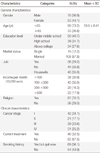Abstract
Purpose
The aim of this study was to investigate the relationships between stigma, distress, and quality of life (QOL) in patients with lung cancer.
Methods
The subjects of the study were 123 lung cancer patients who visited the outpatient department of S hospital in Seoul from July 21st to August 29th, 2011. To measure stigma, distress, and QOL, Cataldo Lung Cancer Stigma Scale, Hospital Anxiety and Depression Scale (HADS), and EORTC QLQ-C30 (Quality of Life Questionnaire, Core 30) were used in this study. The collected data were analyzed using frequency, average, t-test, ANOVA, and Pearson correlation with SPSS WIN 19.0.
Results
Stigma showed positive correlations with anxiety, depression, and symptom (r=.37, p<.001; r=.44, p<.001; r=.23 p=.012), while it showed negative correlations with global QOL and function (r=-.26, p=.003; r=-.40, p<.001). Anxiety and depression also positively correlated with symptoms (r=.43, p<.001; r=.58, p<.001) while anxiety and depression negatively correlated with global QOL (r=-.40, p<.001; r=-.56, p<.001) and function (r=-.64, p<.001; r=-.66, p<.001).
Figures and Tables
Table 3
Stigma according to general and clinical characteristics in patients with lung cancer (N=123)

Table 4
Distress according to general and clinical characteristics in patients with lung cancer (N=123)

References
1. Cancer statistics. National Cancer Information Center. accessed on 29 May 2011. Available at: http://www.cancer.go.kr/cms/statics/mortality/index.html.
2. Chapple A, Ziebland S, McPherson A. Stigma, shame and blame experienced by patients with lung cancer: qualitative study. BMJ. 2004. 328:1470–1475.

3. Else-Quest N, LoConte N, Schiller J, Hyde J. Perceived stigma, self-blame, and adjustment among lung, breast and prostate cancer patients. Psychol Health. 2009. 24:949–964.

4. LoConte NK, Else-Quest NM, Eickhoff J, Hyde J, Schiller JH. Assessment of guilt and shame in patients with non-small cell lung cancer compared with patients with breast and prostate cancer. Clin Lung Cancer. 2008. 9:171–178.

5. Cataldo JK, Slaughter R, Jahan TM, Pongquan VL, Hwang WJ. Measuring stigma in people with lung cancer: psychometric testing of the Cataldo lung cancer stigma scale. Oncol Nurs Forum. 2011. 38:E46–E54.

6. Cataldo JK, Jahan TM, Ponquan VL. Lung cancer stigma, depression, and quality of life among ever and never smokers. Eur J Oncol Nurs. 2011. In press.

7. Kang JI, Nam KK. Psychosocial aspects and mental health in cancer patients. J Korean Neuropsychiatr Assoc. 2007. 46:421–429.
8. National Comprehensive Cancer Network (NCCN) Distress Management (version 1. 2011). accessed on 1 June 2011. Available at: http://www.nccn.org/professionals/physician_gls/pdf/distress.pdf.
9. Vachon M. Psychosocial distress and coping after cancer treatment. Am J Nurs. 2006. 106:3 Suppl. 26–31.

10. Zabora J, Brintzenhofeszoc K, Curbow B, Hooker C, Piantadosi S. The prevalence of psychological distress by cancer site. Psychooncology. 2001. 10:19–28.

11. Cancer fact and figures 2011 in the Republic of Korea. National Cancer Control Institute. accessed on 26 September 2011. Available at: http://ncc.re.kr/english/infor/cff.jsp.
12. Hamer M, Chida Y, Molloy GJ. Psychological distress and cancer mortality. J Psychosom Res. 2009. 66:255–258.

13. Brown KW, Levy AR, Rosberger Z, Edgar L. Psychological distress and cancer survival: a follow-up 10 years after diagnosis. Psychosom Med. 2003. 65:636–643.
14. Akechi T, Okamura H, Okuyama T, Furukawa RA, Nishiwaki Y, Uchitomi Y. Psychological factors and survival after diagnosis of inoperable non-small cell lung cancer. Psychooncology. 2009. 18:23–29.

15. Holland JC, Bultz BD. The NCCN guideline for distress management: a case for making distress the sixth vital sign. J Natl Compr Canc Netw. 2007. 5:3–7.

16. Sellick SM, Edwardson AD. Screening new cancer patients for psychological distress using the hospital anxiety and depression scale. Psychooncology. 2007. 16:534–542.

17. Johnson JR, Temple R. Food and drug administration requirements for approval of new anticancer drugs. Cancer Treat Rep. 1985. 69:1155–1157.
18. Gotay CC, Kawamoto CT, Bottomley A, Efficace F. The prognostic significance of patient-reported outcomes in cancer clinical trials. J Clin Oncol. 2008. 26:1355–1363.

19. Karvonen-Gutierrez CA, Ronis DL, Fowler KE, Terrell JE, Gruber SB, Duffy SA. Quality of life scores predict survival among patients with head and neck cancer. J Clin Oncol. 2008. 26:2754–2760.

20. Kim OS. The effect of structured nursing intervention program on self-care knowledge and self-care performance and quality of life in lung cancer patients with surgery [dissertation]. 2010. Busan: Kosin Univ..
21. Baek SM. Related factors on quality of life in patients with lung cancer [dissertation]. 2011. Gwangju: Chonnam Univ..
22. Yoo MJ. Fatigue and quality of life in lung cancer patients treated with chemotherapy [dissertation]. 2002. Cheonan: Dankook Univ..
23. Lee SY, Park HA. Symptom cluster presented by non-small cell lung cancer patients on Gefitinib treatment. J Korean Oncol Nurs. 2009. 9:77–85.
24. Jang GJ, Park JH, Lye EG, Kim HM. A study on quality of life in lung cancer patients with chemotherapy. Kyungpook Univ Med J. 1996. 37:387–398.
25. Zigmond AS, Snaith RP. The hospital anxiety and depression scale. Acta Psychiatr Scand. 1983. 67:361–371.

26. Lee EH. Development and psychometric evaluation of a quality of life scale for Korean patients with cancer (C-QOL). J Korean Acad Nurs. 2007. 37:324–333.

27. Bartlett JE, Kortrlik JW, Higgins CC. Organizational research: determining appropriate sample size in survey research. Information Technology, Learning, and Performance Journal. 2001. 19:43–50.
28. Park EY. Development and it's effectiveness of expressive writing program for women with breast cancer in Korea [dissertation]. 2011. Seoul: Seoul National Univ..
29. Lee JI. Decreased health-Related Quality of Life in Disease-Free Survivors with Differentiated Thyroid Cancer [dissertation]. 2010. Suwon: Sungkeunkwan Univ..




 PDF
PDF ePub
ePub Citation
Citation Print
Print






 XML Download
XML Download